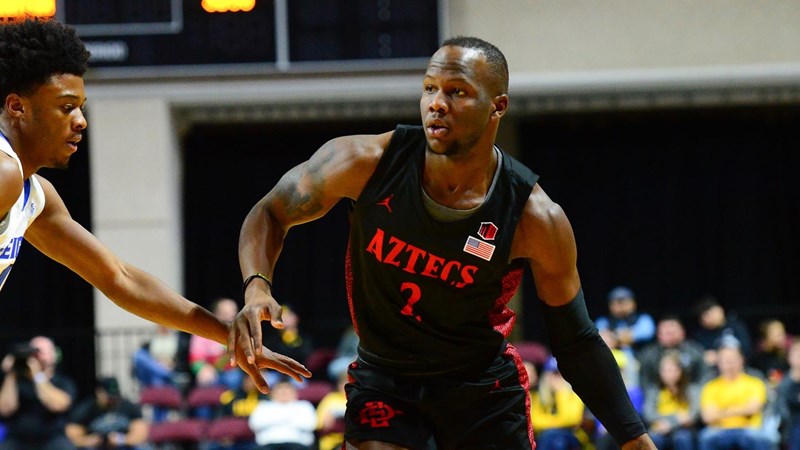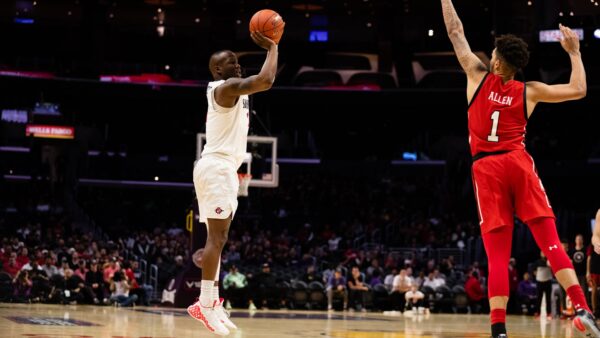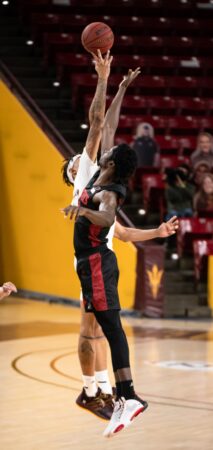Adam Seiko’s brilliance and other thoughts following SDSU’s throttling of #23 ASU

Credit: Rick Schmidt

Bobby Hurley owes Adam Seiko two inches and an apology.
Following the Aztecs dismantling of Hurley’s Sun Devil team, the coach pointed to the game’s critical play. “It was 44-43, I believe, they were up, and Jalen (Graham) missed a legitimate jump hook over a 6-foot-1 inch defender that he certainly can make. It was one of our poorest examples of our lack of focus to run back on defense – our lack of care to run back on defense. They laid the ball in the other way, and that’s when they started to break the game open … that’s the play that really sticks out in my mind.”
The 6-foot-1 defender on the play that Hurley referred to was 6-foot-3 inch Adam Seiko, the score was 46-43 Aztecs, and Seiko’s brilliance on the play started long before his lay in on the other side.
Seiko began the possession near the tip of pitchfork at half court, crouched, arms wide, playing defense against senior Holland Woods. Woods dribbled right, gave a handoff pass to Alonzo Verge. Verge was guarded by the smallest player on the court, Terrell Gomez. A Jalen Graham screen and an Aztecs switch on defense left Joshua Tomaic on Verge and Gomez on Graham. Graham is more than a foot taller than Gomez and outweighs him by 55 pounds.
Like a general commanding his troops, Seiko recognized the mismatch, motioned, and directed Gomez to switch onto Woods in the corner so Seiko could take Graham. While Seiko still gives up six inches to Graham, he is only ten pounds lighter. Graham immediately raised his hand, calling out the mismatch. He tried to post Seiko up, but Seiko’s ball denial and the Sun Devil’s poor spacing prevented an entry pass. Graham moved to the opposite side of the lane, and his teammates cleared out the area to allow the 6-foot-9 forward space to work. Now behind Graham, Seiko pushed the post player away from the basket, forcing Graham to catch the ball outside of the key. Graham tried to pound his way closer to the basket with three power dribbles from his right hand. Seiko would not budge. Graham raised up and shot an eight-foot jump hook. Seiko moved to his left arms raised, making the shot as difficult as possible. Graham missed. Having pushed ASU’s player eight feet from the basket, there was no other Sun Devil defender contesting the rebound, and the ball slipped off the rim to Lamont Butler.
The moment it was clear the rebound would be secured, but before the ball was in Butler’s hands, Seiko shot off towards the other basket. By the time Butler had taken his first dribble, Seiko was ahead of three ASU defenders and closing fast on the final two. Butler released the ball as Seiko crossed half court. Seiko controlled the pass with his right hand, made one dribble, and scored just under Verge’s block attempt. Timeout Arizona State.
Following the game, coach Dutcher singled out his junior guard’s play, saying the plays Seiko makes do not end up in the box score, but they are winning plays. Dutcher sounded eerily similar to Seiko’s high school coach, Ty Nichols. When Seiko committed to SDSU, Nichols told the Union-Tribune, “Adam plays with so many star players (at Sierra Canyon) that sometimes (recruiters) can’t take their eyes off his teammates. But Adam is the reason we win. Adam is my most valuable player. Adam is the kid I can least afford to take off the floor, and I’ve got bonafide pros.”
Dutcher has, likewise, learned the importance of having Seiko on the floor. He is second on the team in plus/minus this season because of the plays like the “critical play” from the Thursday game. It went down as a missed shot for Graham and two points for Seiko in the scorebook, but it took exceptional play by a terrific basketball player to make it happen.
Prior to the game, we looked at three keys to the game. They are reviewed below.
Questions for the Arizona State Game
Can SDSU slow down ASU’s high scoring offense?
The Aztecs answered this question with a definitive “yes.” SDSU held the Sun Devils 16.5 points below their average coming into the game, and it would have been more except for a flurry of scoring during garbage time. ASU entered the game shooting 48.1% from the field but managed only 34.5% against the Aztecs. ASU never got into much of an offensive rhythm. The shots the Sun Devil made were often very difficult. The effectiveness of the game plan put in place by the Aztec’s coaching staff was fantastic.
“Teams don’t want to get beat off the dribble by us,” Hurley reflected following the game. “They know we can dribble well and get into the lane. It was definitely part of [SDSU’s] plan to force us to make shots from the perimeter.” Coming into the game, 38.8% of the Sun Devils’ field goal attempts were three-point attempts. That number ballooned to 58.6% against the Aztecs.
SDSU’s defense continues to be one of the most difficult to score on in the country. Most impressive are the long amounts of time they hold their opponents without a field goal. In the second half of Thursday’s game, ASU had droughts of 2:01, 8:03, and 4:21 of game time without making a shot. It is easy for frustration to set in when the ball will not go through the bucket except on free throws. How much these droughts played into the technical foul that ended Joshua Christopher’s night is hard to say, but it certainly, was a factor.
Can the Aztecs create fast breaks or offensive rebounds?
As keys to the game go, this question was spot on. The two areas where SDSU won the game were on the offensive glass – primarily at the beginning of the game – and fast-break points – especially in the decisive second-half run that blew the game open.

Following the game, Jordan Schakel said starting quickly had been a point of emphasis for a few games now, but he could not put his finger on why the team struggled early in each contest this season. Thursday, SDSU overcame that struggle; however, jumping out to a 14 – 2 lead in the first 5:12 of the game. Of their five field goals during that opening run, four came off offensive rebounds. “The amazing thing is we only sent two to the glass most of the time.” Coach Dutcher said in the postgame press conference. “We were so concerned about their fast break (that) I wanted three guards back on (defense). We sent the power forward and the center to the glass, and those guys did a great job on their own, securing us a lot of offensive rebounds. It was a real key to the game.” The Aztecs had a 17 – 7 advantage in the second chance for the game, most of which came in the opening few minutes of play.
As concerned as Dutcher was about Arizona State’s fast break, it was SDSU’s up-tempo play that broke the game open in the second half. Down 43 – 41, the Aztecs went on a 13 – 0 run to take an 11 point lead they would never relinquish. The sequence of play went like this: Fast Break three, fast-break layup, fast-break layup, timeout ASU, offensive rebound for a score, and another, fast-break three-pointer. “We want to play fast,” Dutcher said, “we want to run and prevent them (our opponents) from running, so every chance we get to run, I want to run. We did a good job (of that tonight). That’s how we spurted ahead. That second unit came in and got a fast-break layup, fast-break layup, fast-break three, and that broke the game open.” Arizona State was +2 for the game in fast breakpoints.
Will the Aztecs’ defense cause another star to lose its luster?
Following Thursday’s game, Hurley said, “[Martin] had a little bit of a blank look on him, wasn’t really having that fire, that energy that I always am kind of use to seeing from Remy. Overall, he’s got to play better in games like these. He’s had a history of playing well in games like these.” Like the stars from UCLA, UCI, and Pepperdine, Remy Martin had a subpar performance Thursday. He finished the game with nine points and as many turnovers as assists, but his lack of impact on the game was most surprising. On Sunday, Colbey Ross was the victim of the Aztec’ defense, but he still had the ball in his hands, guiding and directing his team. For long stretches on Thursday, Martin disappeared. He would come up the court, pass the ball away, and not touch it again. What was the key to stopping Martin? Familiarity.
Martin and Seiko were teammates all four years of high school, graduating the same year from Sierra Canyon. They have been playing basketball with and against each other since middle school. At Tuesday’s press conference, Seiko said playing with Martin would be a huge advantage for the Aztecs. Even though they have not played together for four years now, the familiarity with the growth and development of Martin’s game meant there were “no surprises” to Martin’s game. Seiko did not mean these words disrespectfully.
Following the game, the last images Fox Sports broadcast were of Martin looking across the court to say farewell to his former teammate. Aztec’s assistant, JD Pollock, brought Martin to Seiko’s attention. Seiko was waving to the crowd, turned to Martin, put his hands over his heart, and waved goodbye to his childhood friend.
Quick Takes
1. Following the game, Hurley called Schakel the best player on the court. If Schakel was the best player, Nathan Mensah was the most important. His 17 point, 15 rebound game was one of the best performances by an SDSU center in the Fisher – Dutcher Era. The last center to put up at least a 17/15 game was Malcolm Thomas, who had two 18 point and 15 rebound games during his career at SDSU. Beyond the numbers, however, Mensah’s game took advantage of the one place SDSU had a clear advantage. Arizona State had no one inside to match the junior center. When he was not collecting rebounds against ASU’s frontcourt, he was drawing fouls on them.
Putting his game into perspective only helps to clarify the next point. Mensah’s biggest contribution was single-handedly thwarting Arizona State’s game plan. Hurley described it best, “They were switching [Mensah] on our guards, and we really couldn’t go by him again, which is pretty surprising.” Coach Dutcher decided to switch all ball screens to prevent dribble penetration. This tactic meant Mensah had to guard ASU’s best players on the perimeter. There was not a time all game where he was too far off that they got an easy look, nor was there a time when they blew past him off the dribble. The game ended appropriately. Matt Mitchell ran out the clock after Mensah stole the ball from a guard.
2. Matt Mitchell’s development as a player can be seen in the fact that he only scored one field goal on seven attempts, but was still an essential part of SDSU’s success. Mitchell was able to draw fouls on Arizona State at a rate not seen at SDSU since Jamaal Franklin. The Aztecs were in the bonus at the 11:06 mark in the first half and the 8:24 mark, and it was Mitchell who was drawing those falls. He was 12 of 15 from the line.
Coach Dutcher described the game of his star senior like this.

“I thought Matt (was) more under control (during) the second half. He couldn’t make a jump shot; I think his shoulder is bothering him a little bit. We’ll get that taken care of over the next eight days, but he finds other ways to score. He attacks the basket with great strength and draws fouls, and I think he’s doing a better job under control. They’re calling so many offensive fouls on him, maybe not all of them correct (calls), but I want him aggressive, I want him attacking and drawing contact.”
Defensively the last two games, Mitchell had taken on the task of stopping the opposing player having the best night. Against Pepperdine, Mitchell switched onto Kessler Edwards and slowed him down. Thursday, with the Aztecs up 10 and 6:53 left in the game, Mitchell was at the line shooting free throws. An SDSU substitution led to the players on the court calling out who they would be defending. When someone called out Verge, who finished the game with 25 points, Mitchel emphatically raised his hand and yelled, “I got him.” The next few minutes saw Mitchell bring energy and passion to stop Verge. Verge missed two shots, and with 4:03, Mitchell was again at the line. This time, he made two free throws to put the Aztecs up 19. It is easy to forget Mitchell with the game Schakel and Mensah turned in, but his play continues to be essential to the Aztec’s success.
3. San Diego State continues its impressive wins on the road. In a day and age when top programs refuse to play on the home court of other programs because “they don’t have to,” the Aztecs continue to go on the road and win. SDSU has now won 13 consecutive road games. When asked about the mentality it takes to win on the road, Mensah credited the ‘us against the world’ mindset for the team’s road success, “(We have the) mindset that anytime we get on the road, the opponent, the crowd, and everyone is against us, so it’s like, ‘we’re all we’ve got.’ You have to prove everyone wrong, silence the crowd as quick as possible, so that’s like a boost that we use, anytime we (play) on the road.”
My earliest sport’s memory involve tailgating at the Murph, running down the circular exit ramps, and seeing the Padres, Chargers and Aztecs play. As a second generation Aztec, I am passionate about all things SDSU. Other interests include raising my four children, being a great husband and teaching high school.
Great read. Careful insight and very entertaining verbiage.
Thank you, Robin!